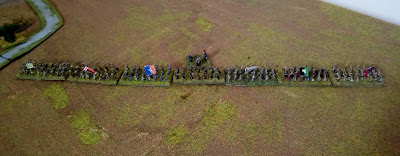Whilst I take a break from my ECW campaign as I wait for the (delayed! boo.) release of the Scots Covenanter Horse and I prepare a couple of other things, I had a go at re-fighting the
Battle of Northampton from the Wars of the Roses, using a scenario from Miniature Wargames 38.
 |
| (is it just me, or is that WW2 set-up very nice indeed?) |
The main difficulty with the re-fight of this battle is that it was partly (mainly) decided by treachery, when Lord Edmund Grey of Ruthin ordered his troops not to fight, having previously made a deal to defect to the Yorkists in return for preferment. As a solo player however, I can't be allowed to "know" this unless designing a "one player against the system" solo game/scenario. What I decided to do therefore was make the treachery a random event: in the first close combat in which the Lancastrian forces rolled a "1", the element could defect. The Yorkists didn't have to accept it and could hope for a "1" later on in a hope of having a more useful element defect later.
The scenario wasn't very exact as to forces apart from indicating that the Lancastrians probably had more artillery but had less troops, so I just used the DBA Wars of the Roses army lists with the Lancastrians limited to 10 bases. They would also be defeated after the loss of 3 bases rather than 4. I can't find the exact choices but I think the forces were:
Lancastrians: 4 bases of Blades, 4 bases of Longbows, 1 base of Artillery, 1 base of Skirmishers (Handgunners)
Yorkists: 5 bases of Blades, 5 bases of Longbows, 1 base of Artillery, 1 base of Hordes (Levies)
n.b. I may have got the the proportion of Yorkists wrong: it may have been 6 of one and 4 of the other.
The Set-Up:
 |
| Lancastrians defending the earthworks to the left (North) in front of the river, Yorkists advancing from the right (South). |
 |
| The view from behind the Yorkists. |
 |
| A closer view of the Lancastrians. |
 |
| Another (lighter) shot. |
The Battle:
 |
| Warwick begins the battle by advancing upon his left flank |
 |
| The Yorkists begin to try and take the earthworks, but without success |
 |
| The Yorkists try on the Right but are repulsed here too |
 |
| The Yorkist line breaks up as it focuses on attacking individual parts of the earthworks |
 |
| A second assault on the right is repulsed |
 |
| Finally some success: on the far left, Yorkist Billmen get through the arrow storm and push over the earthworks |
 |
| The Yorkists on the right however are still stuck |
 |
| The King sends some billmen to try and restore the situation on the Lancastrian right |
 |
| The main position is still being firmly held however |
 |
| Having disposed of the Lancastrian bowmen, theYorkists are then hit by the Lancastrian billmen |
 |
| "Once more unto the breach, dear friends, once more..." |
 |
| Success! Although the artillery is still blasting back the Yorkists, some brave billmen have clambered over the embankments (centre) and penetrated the line |
 |
| The Lancastrians push back the Yorkist billmen on the right of the position... |
 |
| ...and push them right out of it! |
 |
| The Yorkists are fully through in the centre however - the King orders troops from the left of the earthworks to come in and restore the situation... |
 |
| But the Yorkist men-at-arms are also over the earthworks now... |
 |
| At this point, the defence collapsed as this Lancastrian unit defected! |
 |
| The position at the end of the battle. |
Game Notes: Quite a good game, which ended up being quite close to the real thing in result, although this time King Henry was quite likely to get away rather than fall into the Yorkists' hands. That said, the defenders may get slightly short-changed by using
DBA since although it is hard for the attackers to win individual combats, it is hard for Blades (i.e. dismounted men-at-arms and billmen to be destroyed in infantry combat so they can keep on coming back and back, as there are no attrition or fatigue mechanisms. Because of the disparity in numbers, there is no sense in advancing out of the earthworks. I should give this game a go with
Neil Thomas' Ancient & Medieval Wargaming rules too, since that set is pretty much
entirely based upon attrition to see how that plays out.
For those not familiar with the rules, the basic dynamic of the blades vs blades combat is that both sides roll a D6 and add 5, but they are only destroyed if their score is less than half the total of the winner. Since the minimum score achievable is "6", it will be seen that one side needs to score "12" as a minimum to achieve destruction. Because of a positive modifier for defending the earthworks and also for the general being present, then it is possible in this scenario, but it requires rolling 6s and hoping the other side gets 1s! It is much easier to destroy bases when flank attacks are possible, but this is very hard in attacks on (roughly) linear earthworks. All of this resulted in the relatively large number of ineffectual Yorkist attacks. Archery rarely has a great effect against solid infantry in DBA.
I was quite pleased with my easy "treachery" mechanism, since it worked fairly similarly to what happened on the day but didn't require me to pretend when playing one side that I don't know what the other side knows.
So all-in-all, quite a successful game. Figures by
Baccus 6mm, buildings by
Timecast and
Leven.
























































